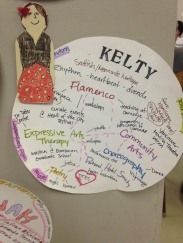In May I had the honour of assisting Vancouver Moving Theatre, and Ruth from Jumblies theatre in Toronto in the workshopping process of mapping out a theatrical feast event to be held in the Spring of 2015. This process came in 2 parts; a workshop open to the public around researching community stories through oral history and mapping called “Maps and Memories”, and the second part which was mixed between consulting with a few cultural representatives, and building a “script-map” of The Big House.
Map’s and Memories really got me curious about the history of our land here on the Lower main-land of unceded Coast Salish Territories, including the traditional territories of the Musqueam, Squamish and Tsleil-Waututh First Nations. Through the stories of an oral historian I got a clearer understanding of the “Great Fire” of 1886 which burnt to the ground the beginnings of a Vancouver colony. The stories really put a fire under my interest and curiosities of the colonializing of this land, and how recent that really was. I’ll be back to speak more about this as information comes up. One of the departure points for the mapping of stories in this workshop, was the land itself, and more specifically, the under-concrete streams of the lower mainland.
The Big House is a collaborative event produced by Vancouver Moving theatre and will be held in May of 2015, they write that it: …”will be a Theatrical Feast that interweaves theatre, oral history, storytelling, music and visual design with cultural teachings culinary traditions and food from the founding cultures of Vancouver’s historic Downtown Eastside. During the event, guests, performers, artists, cultural teachers and producers are seated around tables in a feast hall; all are participants , all are witnesses. The Big House will be “scripted” around the structure of a ceremonial feast as a story unfolds through songs, poems, dances, testimonies and cultural teachings shared by guests, artists, and cultural teachers who reflect the diversity of those who’ve made their home on the Downtown Eastside. A story is of trees chopped down and streams filled in, fish and animals who vanished, cultural groups displace, languages and traditions lost; of people who resisted marginalizing, dehumanizing, silencing and being imagined out of existence; of cultural continuity and achievements leaving legacies in which we all take pride. Remembering the story creates the whole story; the story of the Downtown Eastside.















